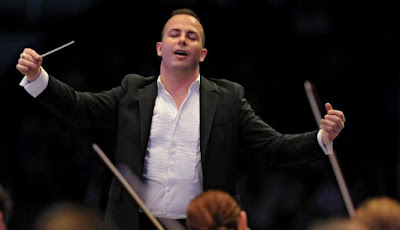The Philadelphia Orchestra plays Haydn and Bruckner.
The concert began with a little bit of theater.
As music director Yannick Nézet-Séguin stepped onto the podium at Carnegie Hall, Philadelphia Orchestra principal timpanist Don Liuzzi unleashed the opening notes of Haydn’s Symphony No. 103, Mr. Nézet-Séguin jumped back in mock shock, clutching the brass rail of the podium, before giving the strings their downbeat to launch the opening bars of this symphony, which is nicknamed the "Drum Roll."
This was a clear and incisive performance of this late Haydn symphony, in the first movement, Mr. Nézet-Séguin balanced the somber character of the first low string theme with a jubilant, surging figure in the woodwinds and horns, guiding the listener through the development and showing how Haydn combined these very different ideas with a masterful hand.
The slow movement appropriated folk melodies from the further reaches of what was once the Austro-Hungarian Empire, given full voice in the lamentations of the orchestra. A cheerful minuet followed, with prancing winds yielding to gentle trio. The finale built from an opening cry of hunting horns, the sound of a pack baying after a fast-running musical fox.
Hunting horns are a key idea in Bruckner’s Symphony No. 4, the first of the composer's orchestral works to find any kind of acceptance and success. Nicknamed the “Romantic” by its composer, this is among the shortest and most popular of his eleven efforts in the genre, clocking in at just 68 minutes Unlike most Bruckner symphonies, which follow a general upward path to a loud and brassy depiction of the kingdom of Heaven, the Fourth has a semblance of program. Bruckner meant to evoke medieval castles and hunting parties in the woods, presumably up to virtuous recreational activities.
After a majestic statement of the first theme the slow build of the opening was marred by lagging, as the conductor seemed to allow sections to hold on to their notes for just a fraction of a second too long. This drag was almost negligible, but it kept the mighty building blocks of each crescendo from falling into perfect place. Still, the big recapitulation and the coda of the first movement had the horns delivering a knockout punch.
After a majestic statement of the first theme the slow build of the opening was marred by lagging, as the conductor seemed to allow sections to hold on to their notes for just a fraction of a second too long. This drag was almost negligible, but it kept the mighty building blocks of each crescendo from falling into perfect place. Still, the big recapitulation and the coda of the first movement had the horns delivering a knockout punch.
Bruckner’s symphonies often contain allusions to the music dramas of Richard Wagner, who was a friend and idol of the Austrian composer. The Andante of the Fourth quotes the bobbing woodwind figure indicating "March of the Grail Knights" from the first and third acts of Parsifal. Here, those same knights moved slowly through a musical thicket, emerging in a glorious flourish of brass. Mr Nézet-Seguin brought this climax off in stunning fashion, with the great bell-like tones of horn and tuba announcing that those pursuers had at last found their musical quarry.
The scherzo put the horns and trumpets to the fore, with a playful trio section that featured th winds imitating (of all things) the grinding whine of a hurdy-gurdy. In the final, Bruckner stages a battle between a descending, theme in the brass and a brighter, more optimistic song in the winds and clarinet. There is no winner; it gives way to a giant surge of flute, horn, winds and heavy brass rising and glowing over a bed strictly played tremolos in the strings. Thanks to the leadership of Mr. Nézet-Séguin and the superb discipline of the Philadelphia players, this majestic coda came to a sonorous and grandiose conclusion.



